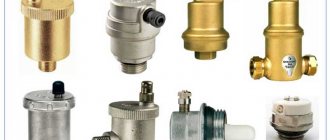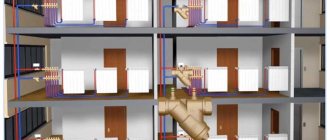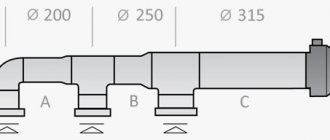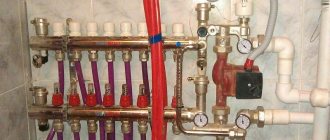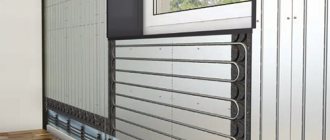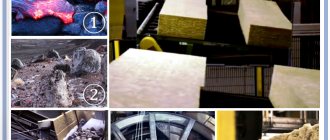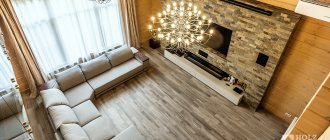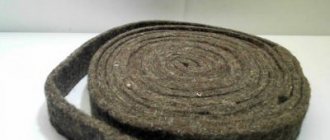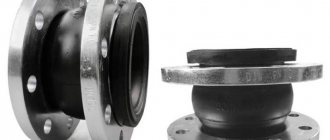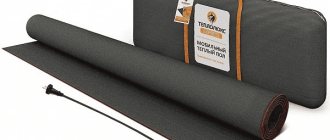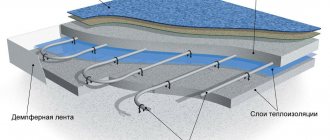Thermal electric mats
If we take into account that tiles are often laid on the floor in the hallway, then electric thermal mats are ideally suited for the hallway.
Thermal mats are sold in finished form, according to the dimensions calculated in advance. A floor calculation can be done for you in the store. If we take into account that thermal mats are not placed under furniture, the number of mats for the hallway will be minimal.
The readiness of purchased mats allows us to minimize installation work. They are relatively unpretentious to install. A level base, space for installing the regulator and a power supply are required. There is no need to do special covering work for them; the tiles are laid directly on rolled out mats, and they are covered with tile adhesive.
However, mats also have disadvantages. It is better to cover thermal mats with tiles or porcelain stoneware, and if you plan to use wood-based coatings for finishing the floors, it is better to choose a different type of heated floor. For example, film heated floor.
Criterias of choice
Having understood what the main types of finishes are, it remains to determine which one is better. There is no hard answer to this question: everyone chooses what suits their taste and budget. Hallway flooring differs from other types of flooring. It must meet the stated specificity requirements.
It is important that it be:
- resistant to abrasion, characterized by resistance to increased exposure to abrasives;
- moisture-resistant, not damaging its structure during daily wet cleaning;
- possessing chemical inertness, providing for cleaning the surface with various chemicals without destroying the structure;
- Dirt-repellent, facilitating daily cleaning;
- especially durable, resistant to mechanical damage of various types
- environmentally friendly, not emitting harmful substances into the air;
- real branded (today there are many fakes that are difficult to distinguish from the original at the time of purchase);
- aesthetically pleasing, able to successfully fit into the environment;
- affordable in price, without losing quality characteristics;
- light and easy to install, not complicating installation;
- durable, designed for at least 10 - 15 years without the need for adjustments.
In addition, the design approach is important:
it is important to follow the principle of a single composition: the floor covering can repeat the multi-tiered ceiling; floor finishing can be supported by interior items in color, pattern or texture; the combination may include zoning the hallway into areas with varying degrees of traffic; in the area of greatest load it is worth using a more durable material of a practical color; you can use a coating with a pattern: this way stains that are difficult to remove will be less noticeable; It is important to exclude white from the list: even with intensive cleaning, it will turn yellow over time.
Having decided on the type of raw material, complexity of installation and insulation, it is important to make a purchase in a trusted store. This will allow you to invest money in a quality product that will stay on the floor for a long time.
Before purchasing, you can look through the reviews of real customers about this finish, preferably on construction forums: the opinions of experts will provide valuable information about the intricacies of the work, allowing you to save time on cladding.
It is important to calculate the material so that the installation has a minimum of joints. In addition, you can use design examples to add homeliness and special style to the hallway atmosphere.
You will learn more about how to decide on the floor covering in the hallway in the following video.
Cable heated floor
Cable heated floors are heated with an electric cable, similar to those in thermal mats, but with more complex installation. Installation of this type of heated floor is much more complicated than those listed above.
- The heat cable is laid on a concrete base, which must be covered with reflective material.
- To install the cable, you need to install special holders, and the cable itself needs to be laid according to a complex pre-calculated pattern.
- But most importantly, the electrical cable for the heated floor must be covered with a layer of screed to ensure uniform heating and protection of the cable. Such a shelter allows you not to think about the arrangement of future furniture, and install warm floors over the entire floor area.
Such technological complexity of installation makes it unprofitable to use it only for the hallway. However, a cable heated floor in the hallway can perfectly become part of an overall cable floor system for the entire home.
Installation of heating cables
Which coating is better for a warm water floor?
Laying an electric heated floor with shielded wires is easy to do with your own hands; the whole technology is based on the correct system for installing cables and installing a thermostat.
Photo - installation principle
- The temperature and surface heating sensor should be located at a level of no more than 30 centimeters from the floor. The regulator is installed on the wall near the floor and connected to a shielded wire;
- There are different methods of laying: spiral, snail, combined. The snail cabling process is popular in large rooms because it allows for greater heat transfer, but it is very expensive. The spiral allows you to save the amount of heating cable, but at the same time it has less heat transfer;
- The cold end of the cable is connected to the sensor. It must first be placed in a protective corrugation. It is pulled through the groove to the location where the sensor is installed. Then the wire starts branching along the floor;
- To secure the wire to the floor, special staples resembling clamps are used. They are attached to a cord and connected to the floor using nails or screws;
- After the stretching is completed, installation of the regulator begins. It is mounted in a distribution box, the power cord and the underfloor heating cable are connected to it.
Photos - different styling options
- Do not cut shielded cables. You need to immediately buy enough wire so that there is no excess left. Otherwise it will stop working;
- The thermostat must be connected only in dry, ventilated rooms;
- Before installation, the cable resistance is calculated and the entire system is connected to ground. This is an important aspect of the work; the safety of those living in the house depends on it;
- Be sure to prepare a plan for the location of the wires after they are installed. Then, in case of repair, you will not have to dismantle the entire coating, but only remove the area above the break;
- It is not recommended to lay wires on top of each other in the form of a grid - they can overheat and damage the insulation of other cables.
Now ready-made cable systems are sold (Devi - Devi, Devi, Energy), the cost of such a warm floor without installation in St. Petersburg is 30 dollars, with installation the price can reach 50.
Photo – connection to the temperature sensor
Video: installing heated floors using mats
Water heated floor
- Water heated floors are the most complex floor heating system. It makes no sense to consider it as a separate system for heating the hallway.
- The use of a water heated floor system in the hallway can only be considered as part of the overall heating system for the house with water floors.
- The difficulties of a water heated floor include a separate water supply, complex and expensive installation of water distribution and circulation, covering with a screed, difficult startup and operation.
Selecting a heating system
When all the positive and negative aspects of installing flooring in the hallway are weighed, you need to choose the heating system that is most suitable. The choice will depend on the following features:
- What type of flooring is used;
When installing heated floors, the type of floor covering is taken into account.
- How much money can you spend?
Budget for installing heated floors.
- Who will do the installation (the person himself or a team of specialists).
Installation of underfloor heating by a specialist.
Installing heated floors with your own hands.
There are several types of heated floors. To decide which one will be more acceptable, you need to consider them all in more detail.
Two types of “warm floors” systems have been developed. The first is a system using hot water. The second one runs on electricity.
Hot water system.
Laying heated floors powered by electricity.
In any water-type structure there is a coolant (hot water) that heats the floor. Hot water circulates through a heating circuit that is installed under the floor.
If we are talking about systems that operate using electric current, then the heat source is electricity.
These devices may have different designs. They are divided into the following groups:
- Heating cable. It is laid in the floor screed, like a coil;
Laying the heating cable in a snake pattern.
- A heating mat is also a heating element, but it is placed on fiberglass or some other material at the manufacturing plant.
Heating mat.
The source of thermal radiation can be a thermal film, inside of which there are thermoelements. When choosing a design for a heated floor, you need to take into account the surface area to be heated, as well as the performance of the power supply system and other nuances.
Water floor
This design is most often used when it is necessary to heat a fairly large area. This system is preferred by those who will not worry about the costs of maintaining such a system. The design is used to heat apartments or private houses. What elements does the system consist of? This is when hot water flows through elastic hoses in a closed cycle.
Advantages of this floor:
- Low cost;
Low cost of a water floor.
- Does not create electromagnetic fields;
A water floor does not create an electromagnetic field.
- If the assembly was done efficiently, there will be no leaks.
With high-quality assembly, there is no leakage.
The disadvantages include the need to raise the height of the screed by 70-100 millimeters, since it is necessary to lay heating pipes. Therefore, installing this system is not easy.
Electric cable floor
First, thermal insulation material is placed on the floor slab, and then an electric heating element. Fix the cable using adhesive tape for installation. The temperature sensor must be installed in the gap between the bends of the wire. In a heated area, it will control the temperature. A screed of sand and cement is laid on top of the cable. On it is the material used for finishing.
Procedure for installing an electric floor.
The thermal relay is connected to the temperature sensor. The heat level is set using a thermostat. Lay the cable under the tiles in the bathtub, balcony, kitchen, hallway. Any room that is not very large in size can be heated in this way.
Thermostat for setting the heat level on the floor.
Heating mat
When this system is used, installation is carried out in the same way as a heating cable system. There is only one difference. The mat, which is made at the factory, already has its own parameters and electrical power. So you need to find out whether such a system is suitable (or not) in a particular case. But there is a plus. It is easier to install a heating mat than a cable floor.
No heavy objects (wardrobe, wardrobe, etc.) are allowed to be placed on the mats.
You need to think about this before installation. When assembling, you need to ensure that the heating elements do not overlap or come into contact with each other.
Film heated floor
Currently, more and more people prefer this type of heating system. Anyone can install it. The method is considered the safest and least energy-consuming. Using infrared rays, you can heat floors, walls, objects and things located in the area of their radiation. After this, all the heat enters the air in the room.
In order to heat the hallway, this method is ideal. There is no need to make any screed. There is one more “plus”: since the film floor strips are laid in parallel, when one breaks, the others continue to work normally.
Warm floors of this type can be located under carpet, tiles, or laminate.
Film floor under laminate.
Film heated floor under the carpet.
Film floor under tiles.
Masking heating pipes
It doesn’t matter whether it’s an apartment or a house, a bedroom or a kitchen, everywhere I would like to have a good renovation. Questions immediately arise: how to beautifully hide heating pipes and how can this be done with minimal cost and maximum efficiency? At the same time, the method of disguise should be truly invisible and unnoticeable, fitting into the room.
The pipe can be hidden inside the wall, or it can also be closed into the floor. Remember that the old heating system should not be hidden in this way; this option is possible after a complete update of all elements.
Box on frame
It is best made from wood, plastic or plasterboard. Do not place the heating pipes close together; there should be at least three centimeters between the box and the pipe.
Hide behind decor
Decoration of pipes in various ways, for example, wrapping them with jute rope. But remember that this reduces heat transfer. Many owners decorate pipes with flowers; this can be done using bamboo with leaves. Only imagination should work here; even an old pipe can look completely different.
Painting to match the color of the walls
The easiest and most practical method is to paint the radiators or riser in the same color as the walls, but the heat generation will not be reduced.
In the photo in the kitchen interior, the pipes are painted to match the blue walls.
Hide under the floor plinth
A good invention was the floor plinth, in which you can easily hide batteries located horizontally and low to the floor.
Correct installation of heating radiators in a niche
It happens that in apartment buildings there is a niche for old cast iron radiators. This method of installing heating batteries is ineffective, but sometimes there are no other options. Therefore, let's consider it too.
- The distance between the side and rear walls of the niche to the radiator should be at least 5 cm.
- Air access from below should not be difficult, as well as its exit from above. The distance from the bottom and top of the radiator to the walls should be more than 10 cm.
The decorative grille should promote convection. An overlay made of diagonal strips is best suited. It is better not to cover the gap in the lower part of the radiator with a grille to ensure optimal air convection.
If the niche is made in a parapet located along the wall, it is better to cover its upper part with a decorative lattice rather than a solid overlay.
The battery in the niche under the window should be located so that there is a distance to the window sill. It should be twice as large as the window sill protrudes from the wall. For example, if the window sill extends 15 cm beyond the wall, the distance from it to the niche should be 10 cm.
Strengths and weaknesses of electric flooring
The use of electric-type heated floors in the hallway and other rooms has several important advantages:
- High reliability and service life;
- Low complexity of installation work;
- Convenient temperature control using a thermostat;
- Application on most types of surfaces;
- You do not need to obtain special permission.
There are also two “minuses”: increased electricity consumption and the electromagnetic field of cable floors. However, this field is several times lower than the permissible value, and careful insulation of the room and the use of a modern thermostat, for example, Grand Meyer HW-500, will help to avoid high costs.
Dedicated to experimenters
The idea of creating a warm floor with an air heating system is being promoted solely on the enthusiasm of amateurs. In theory, this is a system of open air channels connecting the room and a thermal chamber located below, which heats the air coming from the street.
The design, which in principle does not require replacement of coolants, could become popular among owners of suburban buildings (whether you want ceramic tiles for the floors or granite slabs). But the difficulties in designing a system for an already built room do not allow this method to gain mass acceptance.
